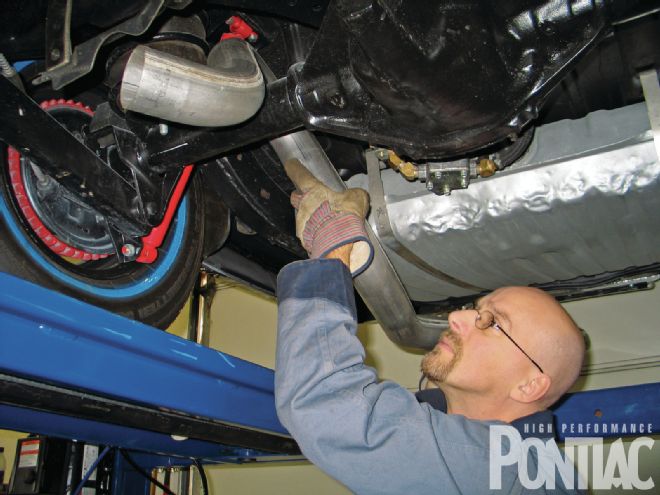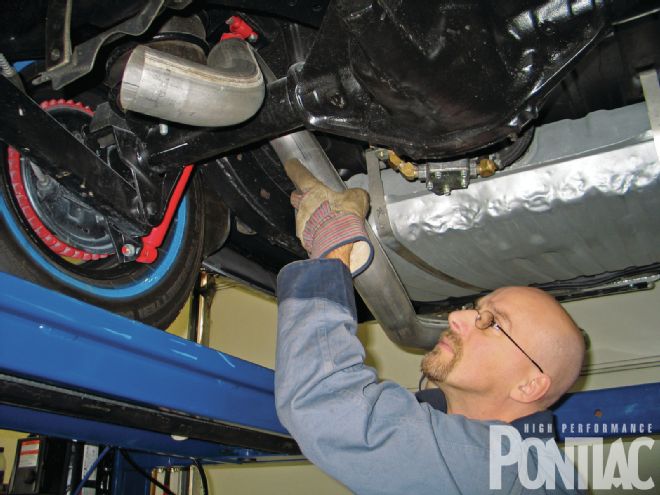
Part of our performance-car obsession is the sensory input. For many of us, what gets our initial attention are the characteristic sounds of high performance engines, via their exhaust notes.
 Are you ready to put 3-inch exhaust on your classic GTO and reward yourself with better sound and performance? The author, shown here, found that it takes patience. Read on to learn how he did it.
Are you ready to put 3-inch exhaust on your classic GTO and reward yourself with better sound and performance? The author, shown here, found that it takes patience. Read on to learn how he did it.
For any given displacement engine, higher power output means greater average cylinder pressure during the power (expansion) stroke. For a given compression ratio and exhaust valve timing, any increase in the average cylinder pressure will also lead to an increased cylinder pressure at the moment the exhaust valve opens. Opening the exhaust valve against the higher pressure results in a louder exhaust note. Thus, higher performance engines are typically louder.
There’s more to it, however. Higher performance engines usually alter the exhaust valve timing to open earlier during the last part of the power stroke. This creates a longer exhaust event, which aids in exhaust flow at higher rpm, thus producing more power. Opening the exhaust valve earlier results in even higher cylinder pressure being initially sent out the exhaust, again creating a louder exhaust note.
At the other end of the exhaust-valve timing, high performance engines typically delay the closing of the exhaust valve (while simultaneously getting a head start by opening the intake valve earlier). This results in a period when both valves are open at the same time, called overlap. If the exhaust system is restrictive, pressure will build up. The result is not only less efficient scavenging of the exhaust gases from the cylinder, but also the reversion of exhaust gases backing up into the cylinder during overlap, and if the restriction is really severe, exhaust gases backing up all the way into the intake ports. The end result, as you can imagine, is a poor running engine and loss of power.
Stock exhaust systems, which are designed to keep the noise low, can therefore be quite restrictive to exhaust flow, due to all the torturous paths they are designed to squeeze through in hopes of stripping off the pressure wave energy that results in noise. Low performance engines don’t have a great deal of valve overlap, so they can get away with a somewhat restrictive exhaust system. But with the increased overlap in our high performance engines, a restrictive exhaust system will quickly undo a bunch of effort at the engine end to make more power.
Pontiac engineers knew this and equipped high performance models with freer flowing dual exhaust, and in the case of H.O.’s, Ram Airs, and SDs, low-restriction manifolds. There was even a short-lived vacuum-operated muffler bypass system known as V.O.E.
Increased power output gained through larger displacement and/or more aggressive valve timing will be compromised with a restrictive stock exhaust system. Such was the case with our ’66 GTO in which we bumped up the engine displacement by more than a liter, replaced the bumpstick with a Melling Ram Air IV unit, and have future plans for large quantities of hidden nitrous. Thus we needed an exhaust system upgrade.
Our plan was to maximize the flow potential (and minimize any restriction which could create reversion problems with our additional valve overlap), while at the same time stay well within any old folk’s noise tolerance. We also didn’t want to go too big, since overkill on the exhaust system can reduce gas velocity, which will again reduce scavenging efficiency. Somewhere in between too big and too small is just right.
We started at the engine with a set of ceramic-coated, four-tube Doug’s headers, which then dump into a 3.00-inch, mandrel-bent dual exhaust system kit from Pypes. For a bit more power potential, and less low-end boom, we went with an X-type pipe option after the headers.
Our muffler selection was based on the extensive work by Jim and Tom Hand, who compared several mufflers for restriction, power output, and noise levels. We chose the 18-inch Goerlich Xlerators, since they represented a good compromise between noise level and performance potential.
To continue with our stealthy, stock-appearing look, we found some chrome tailpipe extensions at our local auto-parts store in a 3.00-inch size that looked somewhat similar to the factory ’66 GTO chrome “trumpet” extensions. Lastly, for all-out performance at the race track, we went with the Pypes X-Change exhaust cutouts after the X-style pipe. With the cutouts opened up, we’ll be able to enjoy the full, uncensored GTO performance song, but will it still make a power difference over the closed exhaust?
We purchased our entire exhaust system several years ago, but for various reasons, didn’t get it all together until recently. In the meantime, Pypes changed its material from the aluminized steel we have, to 409 stainless steel, with the extra cost option of going with polished 304 stainless, if you really want the bling. The Goerlich mufflers have changed to Pypes Race Pro mufflers, again in 409 or 304 polished stainless, but otherwise are functionally identical to our aluminized Goerlich mufflers.
Our entire setup, with mufflers, X-style pipe, cutouts, and hangers can be purchased from Pypes as a kit for around $675 at the time of this writing, under part number SGA14R36 for the 409 material. The Doug’s Headers are a separate item, PN D564, for around $690.
How will the old-school GTO respond? We packed our 9⁄16-inch wrenches and took the GTO to the Superflow chassis dyno at Motion Performance in Winnipeg, Manitoba. Once strapped down, we would finally be able to answer the open versus closed exhaust question, at least for our combination.
Our old-school engine features a 0.040-over 455, with flat-top pistons, No. 16 heads (yielding over 11:1 compression—requiring the 94 octane pump gas we’re fortunate enough to have locally), R/A-IV cam, ’65 Tri-Power, M&H breakerless ignition kit, and a distributor recurve dialed into the combo. It’s backed by a Muncie four-speed and 3.90 gears.
After a couple of warmup runs, we established our baseline dyno numbers with the exhaust closed when we had two back-to-back runs within 1 hp (all variables were kept consistent as possible on the dyno to ensure valid results). To say we were pleasantly surprised by the numbers would put it very mildly. With the exhaust corked up, the old Poncho put over 400 hp to the wheels, with a peak of 408 rwhp and 491 lb-ft of rear wheel torque (STD corrected on an inertia-only dyno run). Before you say that this is impossible given the engine combo, please keep in mind that this number was backed up in multiple pulls, the dyno was recalibrated, and the GTO run again to verify the figures.
A few minutes later, we had the exhaust cutouts opened up and ready for the dyno to tell us how good our exhaust system really is. A couple much noisier runs later (again consistent to within 1 hp), and we had our result: 419 rwhp and 498.4 rwtq, a gain of 11 rwhp and 8 lb-ft of torque. It was not a huge improvement, but a significant and repeatable gain nonetheless. It seems our big-inch exhaust could still have been a bit bigger for our combination. Well, now we know to always pack our 9⁄16 wrenches when heading to the race track for some unmitigated fun.